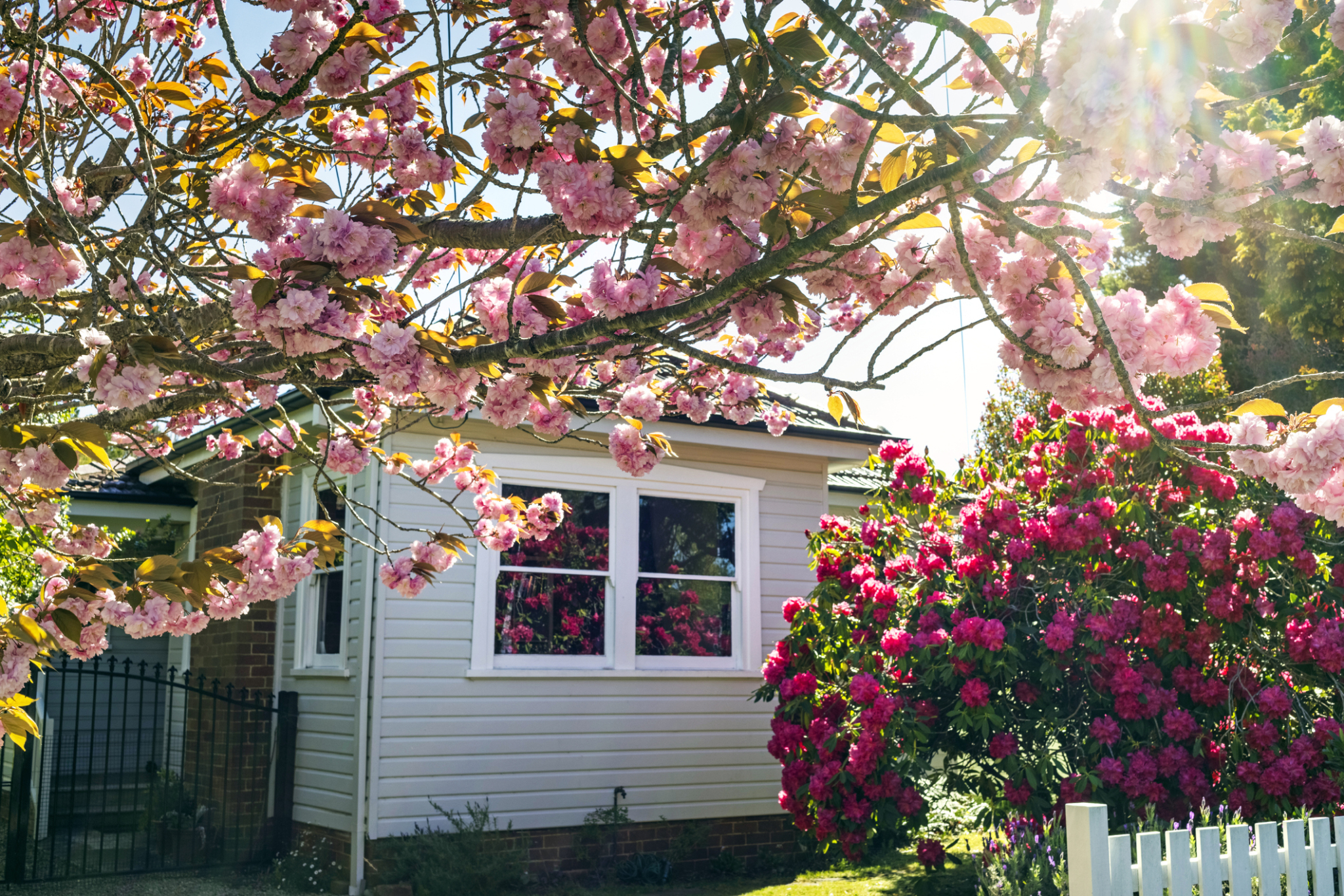Property price predictions as the spring selling season approaches
Buyers and sellers are gearing up for what’s traditionally the busiest time of the year for property, the spring selling season.
But as rising interest rates eat into borrowing capacities, and more supply hits the market, new forecasts by PropTrack expect national house prices will fall between 2 and 5% by the end of this year, and by a further 7 to 10% by the end of 2023.

An influx of properties are expected to hit the market this spring. Picture: Getty
Here’s what’s expected for the property market in the months ahead.
Price growth has peaked. Where to from here?
Price growth was already slowing before the Reserve Bank of Australia began increasing the cash in May, and PropTrack’s Cameron Kusher – author of the latest PropTrack Property Market Outlook – said the recent string of rate hikes have added further downward pressure on prices.
According to PropTrack, national property prices have fallen 1.66% from the March peak, with larger falls recorded in Sydney and Melbourne.
“Even in the cities where prices are still rising, the rate of growth has slowed significantly,” Mr Kusher said.
It’s worth noting it follows a year of near-record price growth, with home prices surging 35.1% between March 2020 and March 2022.
Mr Kusher said as interest rates rise further, that will have implications for property prices.
“By the end of this year, we expect the cash rate to rise to between 2.5% and 3%, with some further increases in early 2023,” Mr Kusher said.
“The recent run-up in prices, coupled with reducing borrowing capacities as interest rates rise, is likely to see price falls broaden and then accelerate further into 2023, with the more expensive cities expected to record the largest price falls.”
PropTrack dwelling price forecasts
Forecasts are for each calendar year.
| Region | Forecast for Dec-22 | Forecast for Dec-23 |
| National | -2 to -5% | -7 to -10% |
| Combined capital cities | -2 to -5% | -7 to -10% |
| Adelaide | +2 to +5% | -3 to -6% |
| Brisbane | +2 to -1% | -6 to -9% |
| Canberra | -3 to -6% | -7 to -10% |
| Darwin | 0 to -3% | -4 to -7% |
| Hobart | -1 to -4% | -7 to -10% |
| Melbourne | -3 to -6% | -9 to -12% |
| Perth | +2 to +5% | -2 to +1% |
| Sydney | -3 to -6% | -9 to -12% |
Jump ahead to see analysis for each state and territory:
- New South Wales
- Victoria
- Queensland
- South Australia
- Western Australia
- Tasmania
- Northern Territory
- Australian Capital Territory
Economists at some of the big four banks expect the cash rate will peak even higher than projected by PropTrack, with ANZ and Westpac both forecasting a terminal cash rate of 3.35%.
As a result, they expect larger price falls.
ANZ projects house prices will fall 18% by the end of 2023, before recovering in 2024.
“The biggest factor driving prices lower is reduced borrowing capacity, not a rise in forced sales,” ANZ senior economist Felicity Emmett said.
“In 2024, we expect to see the beginnings of a recovery in house prices, alongside cuts in the cash rate in the second half. We expect prices to rise around 5% in 2024,” she said.
Westpac expects a 16% peak-to-trough decline, before a “modest recovery” in prices in 2024.
But the national picture tells a very different story to individual states and territories. Here’s how your state is faring and what could lie ahead, as projected by PropTrack.
New South Wales
Dwelling prices in Sydney fell 0.7% in July, the latest Home Price Index shows, and have now fallen more than 3% from the March peak. Prices have held up better in regional NSW, falling 0.15% in July.
The median property price in Sydney is $975,000, still well above the national median of $751,000.
“Sydney property prices are the most expensive in the country and the gap in pricing relative to other capital cities has widened over recent times.,” Mr Kusher said.
With prices now cooling, Mr Kusher said it’s reasonable to expect that the price gap may narrow again over the coming years.
“This is likely to happen due to larger price falls in Sydney relative to the other capital cities,” he explained.
“We’ve already seen strong migration out of Sydney over the past two years and more homeowners may choose to seek out better value housing outside of Sydney.”
Property prices in the city are expected to fall by 3% to 6% by the end of the year and 9% to 12% by December 2023.
Victoria
Property prices in Melbourne fell 0.59% in July, and like Sydney, have now fallen more than 3% from the March peak. In regional Victoria prices fell 0.32% in July.
“The slowing of price growth over recent months reflects the increasing expectation of interest rate increases, and their eventual increase, along with the resumption of discretionary spending channels that were not available throughout the pandemic lockdown period,” Mr Kusher said.
Dwelling prices in the city are forecast to fall 3% to 6% by the end of the year, and 9% to 12% by December 2023.
Queensland
Over the month of July dwelling prices in Brisbane fell 0.1%, taking annual growth to 21.3%, the strongest capital city in the country.
In the regions prices fell 0.23% during the month, taking annual growth to 19.2%.
In Brisbane property prices are forecast to sit somewhere between 2% growth and a 1% fall by the end of the year. But by December 2023 prices are forecast to fall 6% to 9%.
South Australia
Prices increased modestly in Adelaide during July, the city recording growth of 0.04% for the month. Annual growth for Adelaide is now 21.2%, the second strongest capital city in the country.
Dwelling prices increased 0.33% in regional South Australia last month, taking annual growth to 19.6%.
In Adelaide property prices are still forecast to grow by the end of the year by between 2% and 5%, largely because higher interest rates are expected to affect the more expensive housing markets first. But Adelaide is forecast to follow the national trend by December 2023, with falls of 3% to 6% expected.
Western Australia
Perth’s dwelling prices increased modestly in July, registering 0.04% growth. Perth and Adelaide were the only capital cities to record price increases last month. Annual growth now sits at 8.8%.
As for the vast regions, prices grew 0.24%, taking annual growth to 10.6% – the second weakest annual growth of the nation’s regions.
Perth’s property prices are also expected to grow 2 to 5% by the end of the year, with the impact of higher interest rates yet to have a major impact on the comparatively affordable housing market. The current forecast for December 2023 is that Perth’s prices will fall the least, potentially down 2% or up 1%.
Tasmania
July saw Hobart’s property prices fall 0.5%, taking annual growth to 13.8%.
The rest of Tasmania experienced falls of 0.13%, leaving annual growth at 18.5%
In Hobart property prices are expected to fall by 1 to 4% by the end of the year and 7 to 10% by December 2023.
Australian Capital Territory
Last month property prices in the ACT fell 0.48%. Annual growth now sits at 10.9%.
Property prices are expected to fall by 3 to 6% by the end of the year and 7 to 10% by December 2023.
Northern Territory
Dwelling prices fell 0.24% in Darwin over the month of July, taking annual growth to 5.4%.
The Northern Territory has experienced the weakest annual regional price growth nationwide, sitting at 3.9%.
In Darwin property prices are forecast to sit somewhere between experiencing no change, to falling 3%. By December 2023 falls are expected to be between 4 and 7%.



